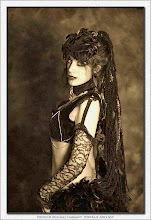As a Bellydance teacher, I agree. Albeit with some reservation.
I agree, if one's main focus is on becoming an excellent Bellydancer. To become a Bellydancer with a capital "b", it takes years of dedication to learning the form, cultural context, history, and traditions of this dance. Correct technique, form and fitness are a must. One must attend shows and events to watch other dancers, and learn the difference between styles. It takes many years of study to become a master, and to find ones own voice.
So what is it that makes me uneasy about this idea that costuming should only come later, AFTER one has become an advanced dancer?
Well, let me tell you a bit about myself. I'm a Bellydancer, but I consider myself to be an Artist first. Bellydance is one medium that I use to express my inner world. (I'm also a musician, actor, poet, and I've been known to paint and sculpt once in a while, too.)
I'm a Shaman. It's my job in this incarnation to interpret the underworld and inner Archetypal landscape to the community. The medium is not the important thing; that's only the vehicle. I'M only the vehicle. It's more about the message; the content. It's about the embodiment of spirit, and communication between the invisibles and the audience.
For me, costuming is a major part of the art, part of the ritual. The making of the costuming is a part of a contemplative practice. Sometimes other people make the costumes for me (I'm bad at sewing) but in this case the envisioning of the costume is the art. What would The Morrigan wear to tell her story? How would She appear? I let Her tell me.
I spend many hours opening myself up to spirit, listening to what I'm being told. I also do a ton of research. Once an archetype talks to me, and I know that I will be performing her, I do my homework and find everything I can about her mythology and history. As a primarily right-brained person, I work with the symbols I find and make connections between them. It is in this way that I create my theatrical persona.
I then become this character. I practice being her. I practice being her walking down the street, etc. She becomes more and more solid this way. Once I hit the stage, I'm as ready as I can be to channel her.
 |
| Self-portrait as The Washer at the Ford |
So, my orientation toward Bellydance has been different from many. I love this dance for its own sake, deeply and truly. But I do it as an Artist/Shaman first, not as a Bellydancer first. It took me many years to realize that fact fully; with all the pressure to become an expert on Middle Eastern culture, to be fully versed in every bit of dance vocabulary possible, to know all the drum rhythms and their names, to fit into the Bellydance community. I've had quite a journey, and I've learned who I am and who I am not: I am NOT a keeper of tradition, though I am well versed in it. I'm very glad that some people are keepers, but this is not my path.
Yes, I think that technique and form are paramount to being a master dancer--how else could one tell a story well? My tools need to be effective and sharp, and that means continuing to improve my dance skills, honing my craft, making my work better and better. The more control, elegance and athleticism I can express with my body, the happier the archetype will be to speak through it.
Would I tell my students to work on their dance skills first, and only then spend their money on costuming?
Here's what I would say: If you aspire to be a dancer, you need to know how to dance. It is not OK to hop onstage with a great costume but not be able to dance well. Not if you want to call yourself Bellydancer. Whatever art form you use, you need to hone your craft before you present to the world.
HOWEVER, costuming and creating persona is an art form, too. It needn't come second. Creating costuming can help you find your voice, and give you impetus to learn technique. Beauty loves to show itself. But it requires right timing. Pay close attention to your body and its feelings; it will tell when you are ready. If you create a beautiful costume to wear, give your art what it deserves and dance it well. Or sing it well. Or act it well. If it is your inclination, be an artist on every level you can.
There are many valid approaches. For me, costuming is not decoration on what is essentially technical prowess, nor is it icing on the cake or anything like that. The movement needs to have meaning, the costume does, too. The art is made as a whole.













I agree. The language of imagery, of presentation, is extremely powerful.
ReplyDeleteYes, oldest stories were orignially expressed in dance and theatre--they were one. This power is still accessible.
ReplyDeleteAmazingly Put!!!
ReplyDeleteThank you, Kathleen!
ReplyDelete